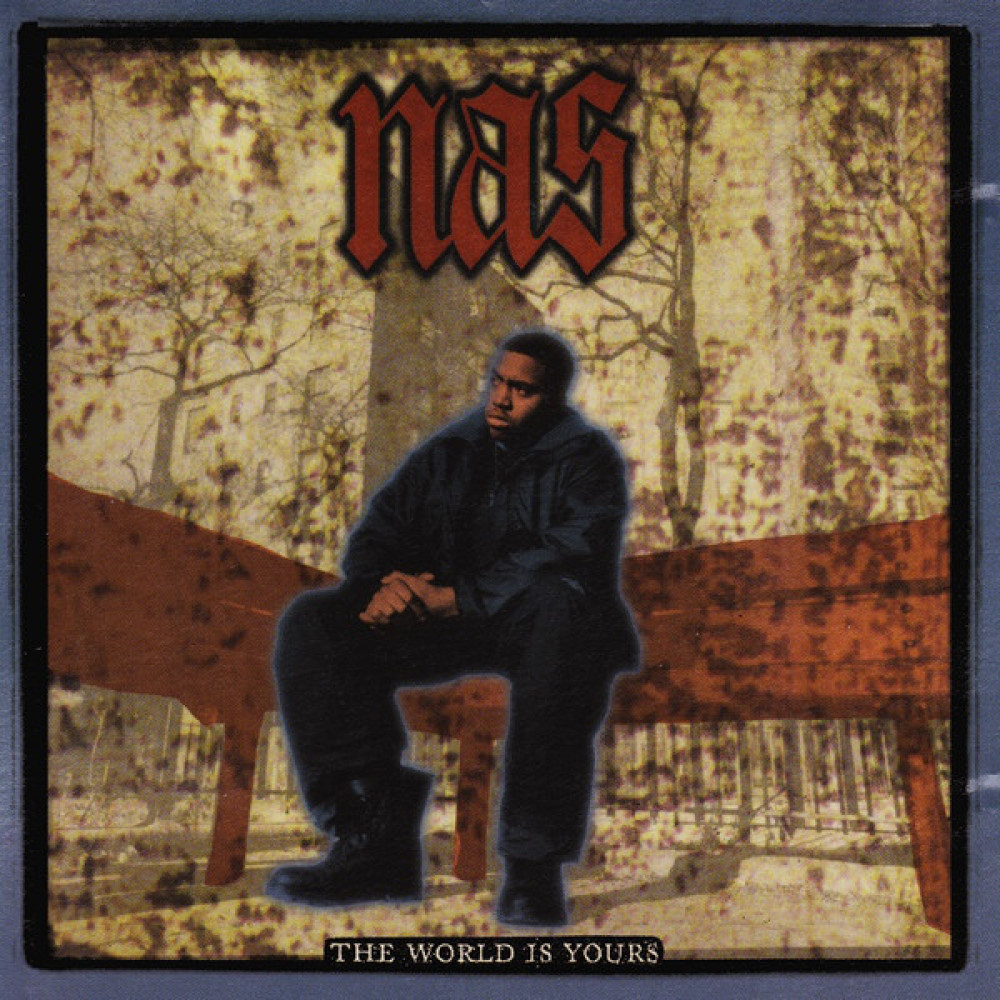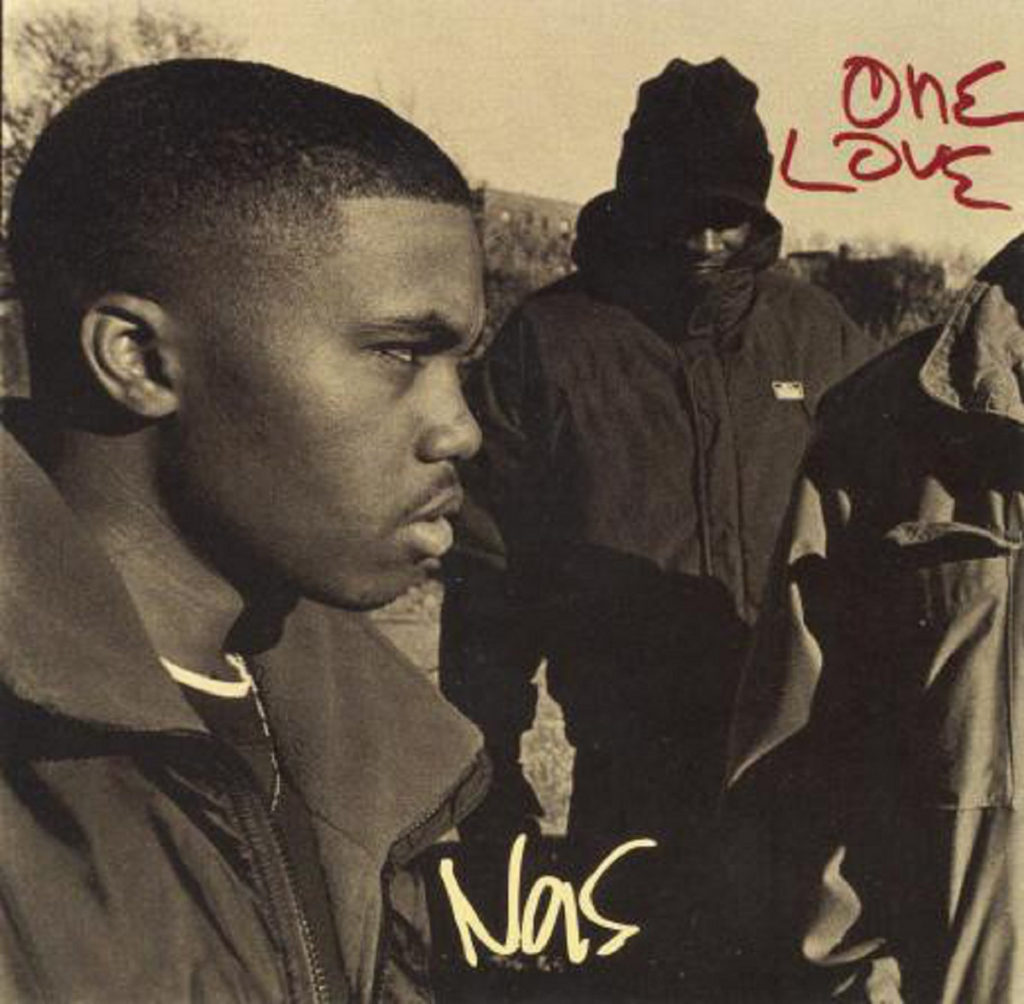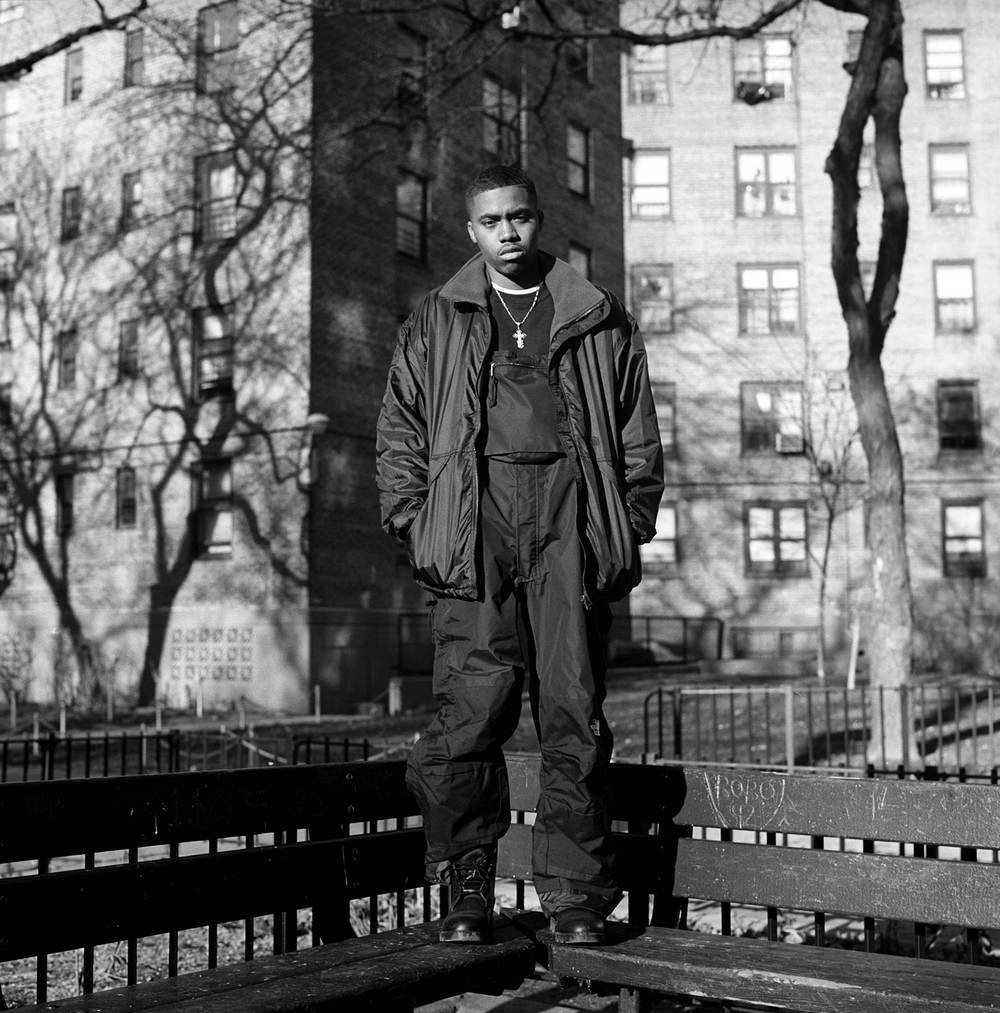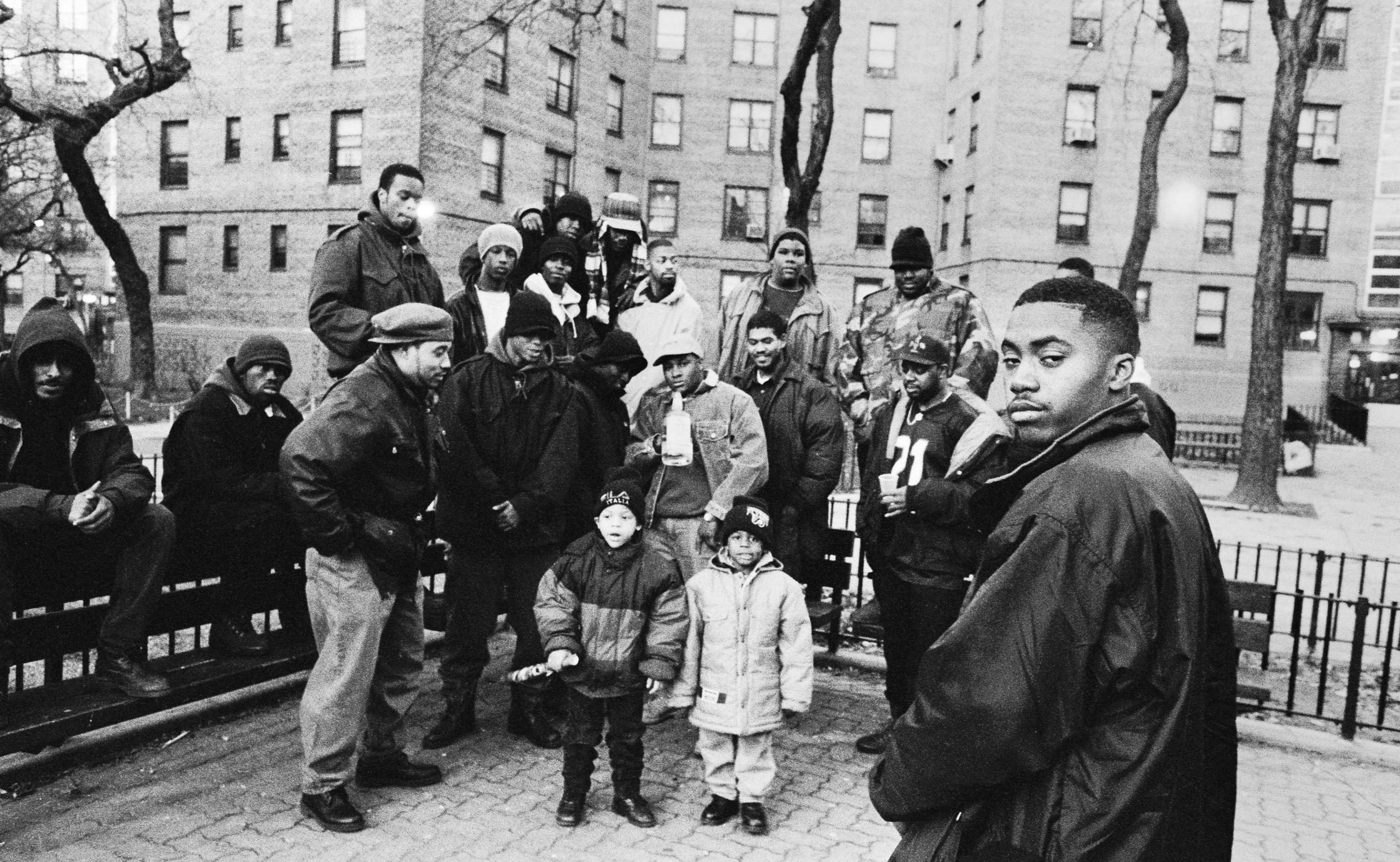Table of Contents Show
“I never sleep, ‘cause sleep is the cousin of death” (( Nas. “N.Y. State of Mind.” Illmatic, Columbia, 1994. )). This line is arguably one of the most influential phrases in hip hop, inspiring artists making music even today. J. Cole, in his recent song “9 5 . s o u t h,” references this phrase (( J Cole. “9 5 . s o u t h.” The Off-Season, Dreamville, 2021. )), which originates from Nas’s 1994 song “N.Y. State of Mind.” His proclamation emphasizes the importance of staying active and alert; his experience with violence and poverty in the Queensbridge housing projects taught him to avoid complacency because this complacency could have ultimately led to his demise.
Not only does this saying reveal the consequences of ignoring conflict, but it also demonstrates a personification of death. Noting a familial relationship between sleep and death gives the topic of death a human-like composition and individualizes Nas’s perception of that concept. In his debut album Illmatic, personification plays a key role in illustrating his life in New York City’s Queensbridge projects. The mannerisms, actions, and mindsets that he depicts throughout the album are bolstered by the use of personification, helping to establish Illmatic as a lyrical masterpiece. Throughout the nine full songs (excluding the intro “The Genesis”), this rhetorical technique serves as the basis for his commentary on religion, music, and violence. Nas’s use of personification throughout Illmatic humanizes his personal experiences and reveals the album’s idiosyncrasies.
Personification Through Crime And Violence

Nas’s use of personification within Illmatic gives human qualities to the crime and violence that he experiences in Queensbridge. In “N.Y. State of Mind,” he describes a situation in which he uses a MAC-10 as a weapon to defend himself and attack others when necessary. He portrays this weapon as having specific animal and human attributes, giving life to the crime and the gunfire: “the Mac-10 was in the grass, and / I ran like a cheetah with thoughts of an assassin / Picked the Mac up, told brothers “Back up!” – the Mac spit” (( Nas. “N.Y. State of Mind.” Illmatic, Columbia, 1994. )). Describing the physical location of this weapon, he illustrates the MAC-10 in a “hiding-like” state, being concealed “in the grass” like a cheetah that he references next. He fires the weapon, stating that the “Mac spit,” which relates the moment to a common human action of removing unwanted substances from the mouth. In this way, the weapon can be seen as wanting to get rid of the “unwanted bullets” from its chamber. Nas’s ability to convey the gun violence in a manner that emphasizes its sentience reveals a personal understanding of the crime plaguing his community. The personified violence demonstrates the song’s idiosyncratic orientation, relating the conflict to the human condition.
The personification Nas implements in “N.Y. State of Mind” to underscore the conflict can also be seen in the song “Memory Lane.” Describing nightlife and the constant violence in his community, he states that this chaotic environment is capable of alluring crime, which exhibits its invitational character: “Murderous night times and knight fights invite crimes” (( Nas. “Memory Lane.” Illmatic, Columbia, 1994. )). Giving the “night times” and “knife fights” an inherently human quality allows Nas to convey the apparent ease at which criminal activity follows violent conflict. Because invitation, as a human decision, implies the comfort in allowing a specific party to enter a particular area, the invitation he depicts in his narrative of the Queensbridge environment mirrors this effortlessness. However, the tone through which he illustrates this acceptance of criminal activity soon changes with a later rhyme in the song. He personifies the weapon he wields and gives it an exaggerated nature: “dramatic automatic .44 I let blow” (( Nas. “Memory Lane.” Illmatic, Columbia, 1994. )). One can potentially identify two uses of personification, in the emotion that he gives the gun and in the gun’s action of “blowing.” The decision to give the weapon physical sensations further solidifies his intention to characterize his chaotic surroundings in a personable manner.
Personification Through Incarceration

Incarceration is a key theme of Illmatic, and Nas makes multiple lyrical decisions to personify this theme. In “The World Is Yours,” he references his incarceration and makes an additional assertion that his brain is subject to the same incarceration: “they lock the champ up, even my brains in handcuffs” (( Nas. “The World is Yours.” Illmatic, Columbia, 1994. )). Nas desires to convey the full extent to which imprisonment can impact his entire psyche. Arresting him not only affects him physically but mentally, stating that his mind, in addition to the person, is capable of becoming under arrest. As a result, his personification of the brain reveals a largely personal and internal view of incarceration. The apprehension of the mind also manifests in the song “One Time 4 Your Mind, as he straightforwardly delivers this concept: “My brain is incarcerated” (( Nas. “One Time 4 Your Mind.” Illmatic, Columbia, 1994. )). This statement immediately follows from a previous description of his rap prowess, stating that he “wreck shit so much the microphone’ll need a paint job.” The destructive capacities of Nas’s rapping may have caused him to emphasize how his mind should be restrained in the same way that criminals are restrained in the real world.
Nas later personifies his rapping style and necessitates incarceration in the song “It Ain’t Hard to Tell.” Throughout the song, he comments on his ability to command any instrumental and deliver intricate rhyme schemes. As this track is the last song on the album, one can view the rapping ability he exerts as the culmination of all the ideas and perspectives from the previous eight tracks. Furthermore, the line “Nas’ raps should be locked in a cell” (( Nas. “It Ain’t Hard To Tell.” Illmatic, Columbia, 1994. )) is the penultimate line of the song, indicating the personal decision to humanize his artistry at the end of the album. The lyrical and rhythmic style of Nas is capable of being restrained in a human form. In addition, prior to this line, he states, “I never fail.” However, his enunciation of the term “fail” is ambiguous, and one could replace “fail” with the homonym “feel;” therefore, the meaning of the following personified phrase would completely shift. Although the initial lyrical sequence has Nas asserting the incarceration of his raps, he could also be stating that restricting his style is detrimental to his artistry. According to this interpretation, subjecting his musical style to a personal form of containment would prevent his rapping from influencing the genre of hip hop.
Personification Through Life And Death

One of the main facets of Nas’s rapping style is the concept of “lyrical athleticism,” or the ability to actively engage with rapping through extensive wordplay and switching rhythmic flow. This is evident in the song “Halftime,” where he likens his style to physical fitness and personifies the microphone as the recipient of this activity: “This is exercise till the microphone dies” (( Nas. “Halftime.” Illmatic, Columbia, 1994. )). The notion of rapping, as a largely verbal and presentational skill, connects with the concept of human exercise. There is an emphasis on persistence and continuation, as he asserts that this verbal exercise will not cease until the microphone ceases to function. The microphone, as a result, becomes a human-like entity and embodies death in case the activity of rapping stops. The prolonged action of rapping is represented in personal form, humanizing his passion for the genre.
Nas additionally personifies the microphone in “It Ain’t Hard To Tell” by specifically referencing his actions on the mic as representative of life or death. There is a level of attentiveness required on the microphone, as any rapping the occurs can be detrimental or favorable to the artist: “The mic is contacted, I attract clientele / my mic check is life or death” (( Nas. “It Ain’t Hard To Tell.” Illmatic, Columbia, 1994. )). A “mic check” refers to a rapper’s momentary preparation before beginning to rhyme and acts as his signature introduction before performing in front of an audience. He views this traditional act as encompassing both ends of the spectrum of human existence. If he succeeds in his raps, his style is brought to life, but his delivery is subject to ridicule and potential deterioration if he fails. Furthermore, relating the involvement with the mic to attracting customers conveys rapping in the context of human interaction. Nas humanizes the microphone in this setting, giving it’s otherwise lifeless quality a connection to the human experience.
Nas brings up the prospect of death by referencing the mental state of prisoners and personifies this state of mind. In the song “One Love,” he writes letters to friends that are in prison. Through these letters, he provides them with updates on the state of Queensbridge and seeks to instill hope in them. He describes the impact of incarceration on his friend’s psyche and its potential deterioration: “Stay civilized, time flies / though incarcerated your mind dies” (( Nas. “One Love” Illmatic, Columbia, 1994. )). Despite the possibility of self-denigration within prison, he expresses a level of optimism that a healthy and ordered outlook on life will benefit his friend. Then, he gives the concept of time a sentient quality through the phrase “time flies,” following the directive to remain persistent. Although this phrase does not directly personify time, the overall goal to bring his friend’s situation to life rhetorically gives his lyrical content a strong, personal orientation.
The track, “Life’s a B*tch,” has featured rapper AZ candidly personifying life, noting the distresses it brings him and the need to cope with these struggles. The chorus of the song reads: “Life’s a b*tch, and then you die, that’s why we get high / ‘Cause you never know when you’re gonna go” (( Nas. “Life’s a B*itch.” Illmatic, Columbia, 1994. )). AZ’s decision to characterize life in this way and highlight its undesirable qualities depicts a personal dissatisfaction with the circumstances in which he finds himself. Personifying life in this spiteful manner fully reveals his vexation while maintaining simplicity and sincerity. As a result of his judgment, AZ feels the need to unwind due to the unpredictable environment in which he lives.
Personification Through Religion

Nas implements personification in his lyrics to elucidate religious themes. Often, these themes revolve around the tradition of Christianity, as he depicts interactions with the devil and comparisons of him to Jesus Christ. The devil, as a personification of evil, manifests in “The World is Yours.” After describing the grime of living in the “Rotten Apple” (a nickname for New York City’s nickname “Big Apple”), he humanizes the danger one experiences in that environment by personifying the devil: “Or caught by the devil’s lasso, shit is a hassle” (( Nas. “The World is Yours.” Illmatic, Columbia, 1994. )). One can identify a double personification in this example by first noting the inclusion of the devil and then by providing this figure with a lasso. Giving the devil the human ability to restrain within the perilous environment of New York City explicates his religious orientation throughout Illmatic. Personifying evil and then supplying it with human tendencies displays a highly personal and idiosyncratic view of Christianity.
Nas compares his understanding of the world to the influence of Jesus Christ by personifying his intellect. Specifically, he invokes the imagery of Jesus hanging from the cross to describe the potency of his lyrics. In “Memory Lane,” he proclaims: “My intellect prevails from a hanging cross with nails / I reinforce the frail with lyrics that’s real” (( Nas. “The World is Yours.” Illmatic, Columbia, 1994. )). Not only does Nas personify his wisdom, but he also associates his wisdom with one of the most influential figures in all of Christianity. Furthermore, he states that his lyrics are triumphant from this position, which humanizes his rapping and makes it victorious. There is a desire to strengthen this narrative power and bolster its suspended position “from the cross” through authentic and personable lyrics. Nas argues that his rap prowess can be embodied in the form of God, establishing his rhythmic skills as a supernatural force.
Personification Through Confidence

A key facet of Nas’s wordplay throughout Illmatic is to trust in his own style. As a result, Nas desires that the listener gain a complete understanding of his rapping and avoid any distractions from that comprehension taking place. This confidence is evident in “N.Y. State of Mind.” Referring to a cassette player, he states that the listener should avoid playing his music on it if it deteriorates the Illmatic cassette tape: “Never put me in your box if your shit eats tapes” (( Nas. “N.Y. State of Mind.” Illmatic, Columbia, 1994. )). Thus, Nas personifies the cassette player and emphasizes its potential to “consume” and prevent music from being heard. Furthermore, he subtly personalizes his own music and conveys it as himself through the assertion, “never put me in your box.” The pride he presents in this recommendation elucidates his own confidence and allows the audience to gain an understanding of his individual nature.
Nas also supplements his wordplay of consumption in “Halftime” as he shouts out nearby boroughs of New York City. Towards the end of his verse, he expresses: “Brooklyn and Queens is livin’ fat” (( Nas. “Halftime.” Illmatic, Columbia, 1994. )). The term “livin’ fat,” in addition to personifying the boroughs of Brooklyn and Queens, is an expression that characterizes the importance of a particular person, object, or place. Depicting these areas as having this physical characteristic indicates that he holds them in high regard because they are substantive and authentic in his view. These areas represent him to the fullest, and he characterizes their integrity while maintaining their humanity. Nas’s personified value on these boroughs also applies to the track “Represent,” where he focuses more on his own success. Referring to the amount of money he has, he tells the listener: “See my stacks are fat” (( Nas. “Represent.” Illmatic, Columbia, 1994. )). Confident in his status within the hip hop genre, Nas depicts the enormity of his prosperousness, which again relates to the theme of “high self-esteem” he delineates throughout the album.
Nas’s display of self-assurance and strength reappears on “Halftime” as he personifies the city of Atlanta and references their professional baseball team. Stating, “Atlanta ain’t brave-r,” (( Nas. “Halftime.” Illmatic, Columbia, 1994. )) Nas suggests that the valor associated with Atlanta Braves cannot match the heroism he evokes in his lyrics. Personifying the city of Atlanta by referencing its fortitude depicts its personal qualities, and he can apply these own qualities within his rapping and strengthen his performance. In “It Ain’t Hard to Tell,” he relates the attributes of the female body to his own performance on the microphone. Stating that he is “Givin’ mics men-e-strual cycles” (( Nas. “It Ain’t Hard to Tell.” Illmatic, Columbia, 1994. )), Nas gives his rapping ability a repetitive nature that mirrors the reoccurring hormone production in the female body. This cycle implies consistency, which was a highly valued part of his artistry as a young MC.
Why Personification Impacts “Illmatic”
Throughout Illmatic, Nas desires to personalize his experiences and his way of life while living in the Queensbridge housing projects. As a rapper, he provides an intimate account of his actions and relationships with friends and hip hop. As a rhetorical strategy, personification allows the listener to connect with the objects of his environment in a more emotional and instinctive manner. Although there are multiple rhetorical devices that one can identify throughout the album, such as the use of similes, repetition, and metaphors, the use of personification establishes a sense of uniqueness for the art, distinguishing it from other prominent works of rap music. The cleverness in Nas’s rhyme schemes and storytelling is bolstered by the decision to characterize humanity in his lyricism.
